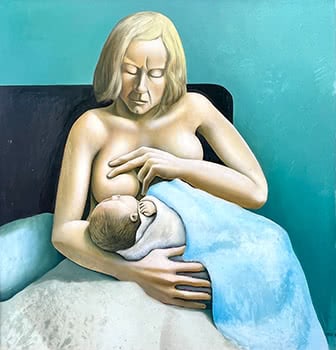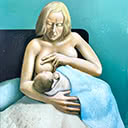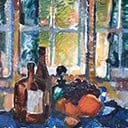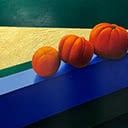Elizabeth Breastfeeding Thomas
77 x 74.4 cm
PROVENANCE
Estate of Marjan van Paassen, New Plymouth Purchased directly from the artist, 1973
Born in New Plymouth on the eve of the Second World War, Michael Smither was an only child, who was raised a Catholic, a religion which has inspired a rich tradition of devotional images of the Virgin and Child. He was encouraged in his creativity by teachers and by his parents, who enrolled him at the Elam School of Fine Arts in Auckland in 1959, but he found the conservatism of the methods used there stifling and left after the first year to return to Taranaki.
Marrying the New Plymouth poet Elizabeth Harrington in 1963, Smither's depictions of his young family soon rivalled landscapes as the preferred subject for his work. The couple moved into The Gables, New Plymouth's colonial hospital in Pukekura Park where they raised two children: a daughter, Sarah, born in 1964, who was the eldest, then Thomas who was the first born son, arriving 11 May 1967.
Smither's first depiction of Elizabeth breastfeeding, Blue Mother and Child 1965, painted in Prussian blue thinned with mineral turpentine was the work chosen as the sole representation of the artist's practice in the New Zealand Painting 1965 exhibition curated for the Auckland Art Gallery by Hamish Keith. As Smither remembers it, he learned to paint in thinner layers to save money since they were surviving on the Family Benefit of 35 shillings a week after Elizabeth had to leave her position as a librarian when Sarah was born.
The threat of eviction from The Gables prompted the family of four to move to where they could live more economically: in a rabbiter's cottage in Patearoa in the Maniototo Plains of Central Otago.
Here Smither concentrated on his domestic paintings, emulating the British artist Stanley Spencer. He strove for Spencer's simplification of form and use of pattern to create dynamics and volume. In Central Otago, Smither's output was prodigious and in September of 1969, he applied to become the Frances Hodgkins Fellow at the University of Otago in 1970 and was successful. Sharing a studio with Ralph Hotere and Jeffrey Harris, Smither was able to experiment with form, supported by the fellowship stipend which was equivalent to the salary of a lecturer. Returning to New Plymouth in 1971, the family moved into a Lockwood home in Mt View Place which had a purpose-built studio at one end, and the youngest child, Joseph was born.
With its low viewpoint on its subject, Smither's pyramidal composition here makes the mother and child monumental, with a faint echo of Michelangelo's marble Pietà where the Madonna holds her adult son across her lap after he is taken down from the cross. Here, the painter's wife Elizabeth, sits up against the headboard, the bedclothes massed like the drapery of the Virgin's gown which supports Christ in St Peter's Basilica. Like the Virgin Mary there, Elizabeth looks down, furrowing her brow in concentration, getting her baby to latch on. It is an image which seems to invite veneration, but Smither later wrote, It wasn't long before I began to see another side to painting children which in everything I'd seen to date exuded crass sentimentality. I saw that, like so many women, Elizabeth was a good mother but often wondered what she was doing there.
LINDA TYLER





